CONTENTS
- Landslide Atlas of India
- Same-sex marriage
- The rise of the ESG (Environmental, Social and Governance) regulations
- Compassionate appointment
- Silicon Valley Bank failure
- Mount Merapi
Landslide Atlas of India
Context:
In 2022, heavy rain, floods and landslides claimed 835 lives in the country, according to the Statement of Climate of India 2022 released by the India Meteorological Department. With a steady rise in the number of extreme weather events, especially heavy rainfall capable of triggering landslides and floods, the Indian Space Research Organisation (ISRO) recently released the Landslide Atlas of India, a detailed guide identifying landslide hotspots in the country.
Relevance:
GS I: Geography
Dimensions of the Article:
- What causes landslides?
- How are landslides classified and mapped?
- How prone is India to landslides?
What causes landslides?
- Landslides are natural disasters that occur in mountainous terrains due to conducive conditions of soil, rock, geology, and slope.
- A landslide is a sudden movement of rock, boulders, earth, or debris down a slope.
- Natural causes of landslides include heavy rainfall, earthquakes, snowmelting, and undercutting of slopes due to flooding.
- Anthropogenic activities such as excavation, cutting of hills and trees, excessive infrastructure development, and overgrazing by cattle can also cause landslides.
- Landslides pose a threat to human and animal lives, damaging property, roads, and bridges, disrupting communication lines, and snapping power lines.
- Factors that influence landslides include lithology, geological structures like faults, hill slopes, drainage, geomorphology, land use and land cover, soil texture and depth, and weathering of rocks.
- These factors are factored in when a landslide susceptibility zone is earmarked for planning and making predictions.
- In India, rainfall-induced landslide events are more common.
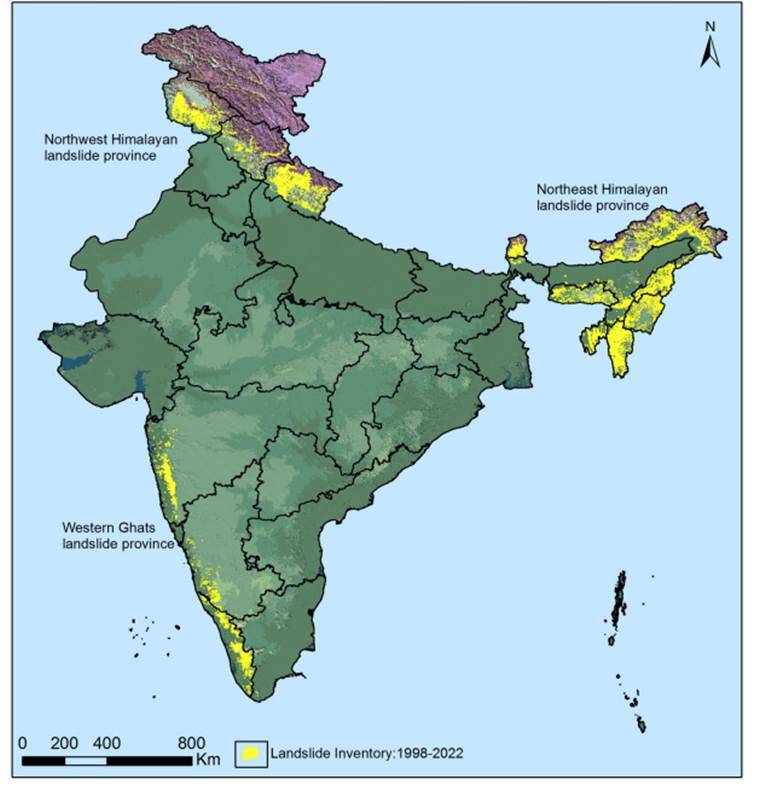
How are landslides classified and mapped?
- Landslides are broadly classified based on the type of materials involved (rock, debris, soil, loose mud), type of movement of the material (fall, topple, slide, rotational slide or translational slide), and type of flow of the material.
- Another category is of landslides that spread laterally.
- Landslides mapped in the ISRO atlas are mainly event-based and season-based.
- ISRO’s National Remote Sensing Centre (NRSC), Hyderabad, has created a database of landslide-prone regions of India based on events during 1998 – 2022, primarily along the Himalayas and the Western Ghats.
- In addition to aerial images, high resolution satellite images captured using cameras Indian Remote Sensing (IRS-1D) PAN + LISS-III, satellites ResourceSat-1 and 2, etc., were used to study the landslides over the past 25 years.
- The pan-India landslide database classifies landslides into – seasonal (2014, 2017 monsoon seasons), event-based and route-based (2000 – 2017).
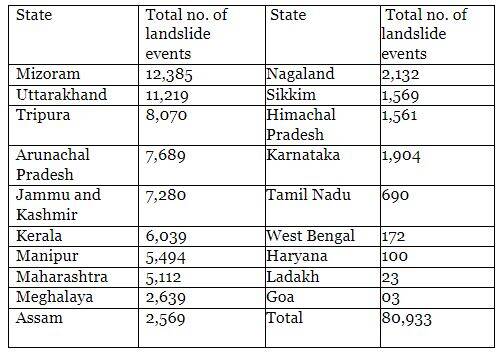
Landslide hotspot areas in India (1998-2022)
How prone is India to landslides?
- India is among the top five countries prone to landslides globally with at least one death per 100 sq km reported due to a landslide event.
- Rainfall variability pattern is the single biggest cause of landslides in the country, with the Himalayas and the Western Ghats remaining highly vulnerable.
- Approximately 12.6% of the country’s geographical land area (0.42 million sq km) is prone to landslides, excluding snow covered areas.
- 66.5% of landslides are reported from the North-western Himalayas, 18.8% from the North-eastern Himalayas, and 14.7% from the Western Ghats.
- Nearly half (0.18 sq km) of India’s landslide-prone area is located in the states of Assam, Arunachal Pradesh, Sikkim, Meghalaya, Mizoram, Manipur, Tripura, and Nagaland.
- Uttarakhand, Himachal Pradesh, and Jammu and Kashmir cover 0.14 million sq km of the total landslide-prone areas, while Maharashtra, Goa, Karnataka, Kerala, and Tamil Nadu account for 0.09 million sq km.
- The Araku region in Andhra Pradesh along the Eastern Ghats also reports landslide events, though in a relatively small area of 0.01 million sq km.
- Despite fewer events, landslides in the Western Ghats make inhabitants significantly vulnerable to fatalities, especially in Kerala.
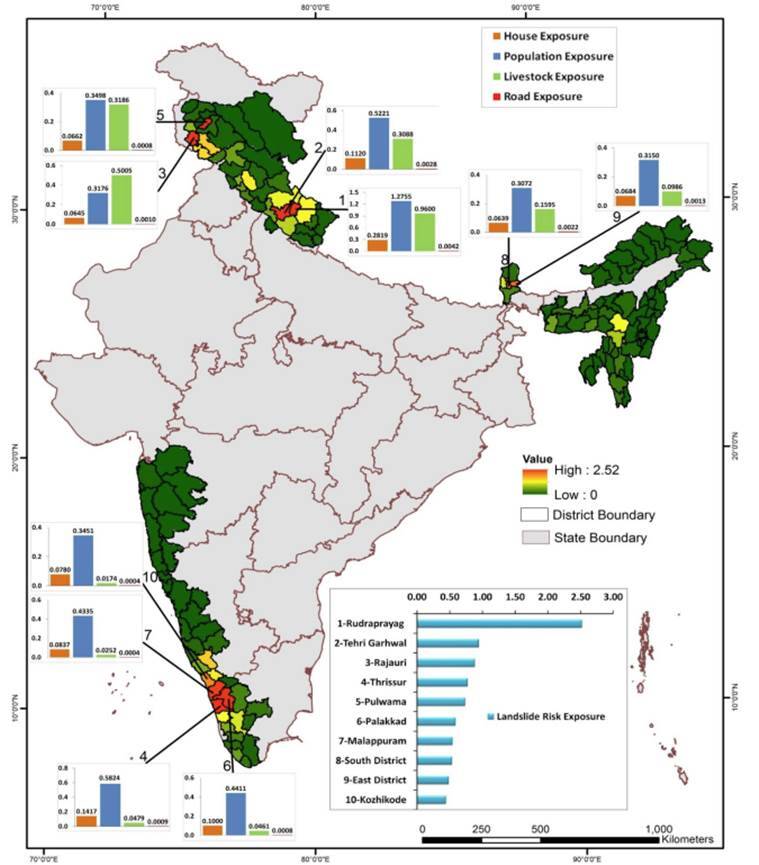
The Landslide Atlas suggests the following:
- Mizoram has reported the highest number of landslide events (12,385) in the past 25 years, of which 8,926 were recorded in 2017 alone.
- Nagaland reported 2,071 out of the total 2,132 landslides during the 2017 monsoon season. Similarly, Manipur experienced 4,559 out of 5,494 landslide events during the rainy season of 2017.
- Tamil Nadu suffered 603 landslide events in 2018 alone.
- Uttarakhand has experienced the second-highest number of landslides (11,219) since 1998, all events occurring post-2000. The year-wise number of landslide events in the state are: 2003 (32), 2010 (307), 2012 (473), 2013 (6,610), 2017 (1), 2021 (329) and 2022 (1).
- The number of districts with maximum landslide exposure are in Arunachal Pradesh (16), Kerala (14), Uttarakhand and Jammu and Kashmir (13 each), Himachal Pradesh, Assam and Maharashtra (11 each), Mizoram (8) and Nagaland (7).
- Kerala has been consistently reporting massive landslides since it suffered the century’s worst floods in 2018. The year-wise landslide events here are 2018 (5,191), 2019 (756), 2020 (9) and 2021 (29).
- From the events and images obtained, the NRSC ranked Rudraprayag in Uttarakhand at the top of 147 vulnerable districts. It has the highest landslide density in the country, along with having the highest exposure to the total population and number of houses.
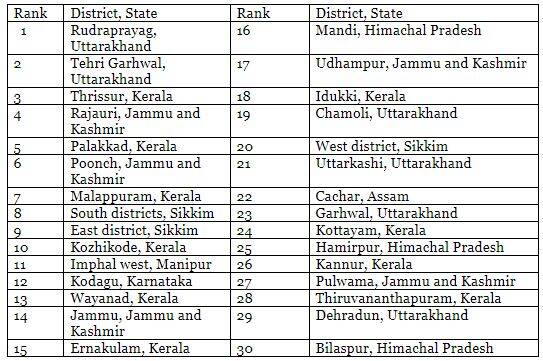
-Source: Indian Express
Same-Sex Marriage
Context:
The Centre has submitted an affidavit to the Supreme Court, arguing against same-sex marriage in India.

Relevance:
GS II: Polity and Governance
Dimensions of the Article:
- What do the petitions say?
- Centre opposes same-sex marriage in affidavit to Supreme Court
- What about other countries?
- About Special Marriage Act, 1954
What do the petitions say?
- The SMA provides a civil form of marriage for couples who cannot marry under their personal law, and both the recent pleas seek to recognise same-sex marriage in relation to this Act and not personal laws.
- The first petition was filed by two men, Supriyo Chakraborty and Abhay Dang, who have been a couple for 10 years.
- Their petition argued that the SMA was “ultra vires” the Constitution “to the extent it discriminates between same-sex couples and opposite-sex couples”.
- It stated that the Act denied same-sex couples both “legal rights as well as the social recognition and status” that came from marriage.
Centre opposes same-sex marriage in affidavit to Supreme Court
The Centre has submitted an affidavit to the Supreme Court, arguing against same-sex marriage in India. Here are the key points:
Sanctity of marriage:
- The Centre argues that marriage between a biological man and woman is a “holy union, a sacrament and a sanskar” in India, and has a sanctity attached to it.
- It states that marriage is a delicate balance of personal laws and societal values that have been upheld for generations.
Statutory recognition:
- The government claims that Parliament has designed and framed marriage laws that recognise only the union of a man and woman to be capable of legal sanction.
- Any deviation from this accepted norm in human relationship can only happen through the legislature and not the Supreme Court.
Interference with personal laws:
- Any interference with existing personal laws in the country, which are governed by the customs of various religious communities, could cause complete havoc with the delicate balance of personal laws in the country and in accepted societal values, the Centre warns.
Decriminalisation of homosexuality:
- The Centre states that the Supreme Court’s 2018 judgment in Navtej Singh Johar decriminalised homosexuality, but did not legitimise same-sex marriage as part of the fundamental right to life and dignity under Article 21 of the Constitution.
Heterosexual marriage is foundational:
- Statutory recognition of heterosexual marriage has been the norm throughout history and is foundational to both the existence and continuance of the state, according to the government.
No comparison to traditional family unit:
- The government argues that a same-sex marriage cannot be compared to a man and woman living as a family with children born out of the union.
- “Living together as partners and having sexual relationship by same-sex individuals [which is decriminalised now] is not comparable with the Indian family unit concept of a husband, a wife and children…” the government contends.
Compelling interest:
- The Centre claims there is a “compelling interest” for society and the state to limit recognition to heterosexual marriages only.
Request for protection:
- The petitioners had argued that the 1954 Act should grant same-sex couples the same protection it allows inter-caste and inter-faith couples who want to marry.
What about other countries?
- A total of 32 countries around the world have legalised same-sex marriages, some through legislation while others through judicial pronouncements.
- Many countries first recognised same-sex civil unions as the escalatory step to recognise homosexual marriage.
- Civil unions or partnerships are similar arrangements as marriages which provide legal recognition of unmarried couples of the same or opposite sex in order to grant them some of the rights that come with marriage — such as inheritance, medical benefits, employee benefits to spouses, managing joint taxes and finances, and in some cases even adoption.
- The Netherlands was the first country in 2001 to legalise same-sex marriage by amending one line in its civil marriage law.
- In some countries, the decriminalisation of homosexuality was not followed for years by the recognition of same-sex marriage, for instance, in the U.S. the former happened in 2003 while the latter in 2015.
About Special Marriage Act, 1954
- The Special Marriage Act, 1954 is an Act of the Parliament of India enacted to provide a special form of marriage for the people of India and all Indian nationals in foreign countries, irrespective of the religion or faith followed by either party.
- Marriages solemnized under Special Marriage Act are not governed by personal laws.
The Act has 3 major objectives:
- to provide a special form of marriage in certain cases,
- to provide for registration of certain marriages and,
- to provide for divorce.
Applicability of the Act
- Any person, irrespective of religion.
- Hindus, Muslims, Buddhists, Jains, Sikhs, Christians, Parsis, or Jews can also perform marriage under the Special Marriage Act, 1954.
- Inter-religion marriages are performed under this Act.
- This Act is applicable to the entire territory of India and extends to intending spouses who are both Indian nationals living abroad.
- Indian national living abroad.
Succession to the property
- Succession to the property of person married under this Act or customary marriage registered under this Act and that of their children, are governed by Indian Succession Act.
- However, if the parties to the marriage are Hindu, Buddhist, Sikh or Jain religion, the succession to their property will be governed by Hindu succession Act.
- The Hindu Marriage Act is pertinent to Hindus, though the Special Marriage Act is appropriate to all residents of India regardless of their religion applicable at Court marriage.
-Source: The Hindu
The rise of the ESG (Environmental, Social and Governance) regulations
Context:
The evolution of ESG laws and regulations is, however, still at a nascent stage in India, where the focus is often on providing protections regarding the environment or workplace conditions without also incorporating the controls and disclosure that are a hallmark of contemporary ESG regulation.
Relevance:
GS II: Polity and Governance
Dimensions of the article:
- How ESG differs from CSR?
- Why ESG is relevant in India?
- What are the implications for Indian companies?
How ESG differs from CSR?
- India has a robust corporate social responsibility (CSR) policy that mandates that corporations engage in initiatives that contribute to the welfare of society. This mandate was codified into law with the passage of the 2014 and 2021 amendments to the Companies Act of 2013.
- The amendments require companies with a net worth of ₹500 crore (approximately $60 million) or a minimum turnover of ₹1,000 crore (approximately $120 million) or a net profit of ₹5 crore (approximately $6,05,800) in any given financial year spend at least 2% of their net profit over the preceding three years on CSR activities.
- The list of qualifying CSR activities is intentionally broad, ranging from supporting the protection of historically important sites to promoting safe drinking water.
- ESG regulations, on the other hand, differ in process and impact.
- The U.K. Modern Slavery Act, for example, requires companies with business in the U.K. and with annual sales of more than £36 million to publish the efforts they have taken
- To identify and analyse the risks of human trafficking,
- Child labour and debt bondage in their supply chain;
- Establish internal accountability procedures;
- Evaluate supplier compliance and to train supply chain managers regarding these issues
Why ESG is relevant in India?
India has long had laws and bodies for ESG issues, but new initiatives take it further.
- India has established guidelines that emphasise monitoring, quantification and disclosure, similar to ESG requirements found in other parts of the world.
- Existing laws and bodies provide important environmental and social safeguards, but the new initiatives enhance them.
SEBI’s Response to ESG investing:
- SEBI responded to the increase in ESG investing and investor demand for information on ESG risks.
- The current report format is a “notable departure” from previous disclosure requirements and places considerable emphasis on quantifiable metrics.
- Disclosures range from greenhouse gas emissions to gender and social diversity of the company.
Future of ESG legislation in India:
- Further legislation regarding ESG is likely in India.
- The Indian government’s increased emphasis on ESG issues can be seen in its active role in global climate forums.
- Specific policy developments such as the Reserve Bank of India’s announcement in January to auction ₹80 billion ($981 million) in green bonds show the government’s support for ESG.
What are the implications for Indian companies?
Compliance Challenge:
- Compliance with ESG regulations poses a significantly different challenge than India’s CSR regulations.
- Compliance with ESG regulations originating from the US, the UK, the EU, and elsewhere will be critical for Indian companies to take full advantage of the growing decoupling from China and play a more prominent role in global supply chains and the global marketplace overall.
Thorough Due Diligence:
- Thorough due diligence will play a key role in Indian companies’ efforts to expand their ESG risk management.
- Due diligence that can stand up to scrutiny requires going deeper, which may include looking at company records, interviewing former employees, and making discreet visits to observe operations to ensure that the measures to comply with international ESG standards are in effect.
Adjustment of Organizations:
- Companies that wish to maximize their opportunities in the global economy need to embrace these new requirements and adjust their organizations accordingly.
-Source: The Hindu
Compassionate appointment
Context:
Recently, the Supreme Court rejected some applications for ‘compassionate appointment’ that were filed by the dependents of deceased government employees in West Bengal.
Relevance:
GS II: Polity and Governance
Dimensions of the article:
- What are compassionate appointments?
- Who can apply for compassionate appointments?
- Who is empowered to make these appointments?
What are compassionate appointments?
- The concept of compassionate appointments can be traced to the Indian Constitution’s Article 39, which is under the Directive Principles of State Policy and talks about the right to livelihood.
- It aims to provide employment on compassionate grounds to the dependent family members of a government servant who dies in harness or retires on medical grounds, leaving the family without any source of sustenance.
- Multiple factors are looked at while assessing a request for compassionate appointments, such as the financial condition of the family, the presence of earning members, family size, children’s ages, and the essential needs of the family.
- According to the DoPT’s office memorandum dated January 16, 2023, these appointments can only be made for “Group ‘C’ posts against the direct recruitment quota.”
Who can apply for compassionate appointments?
According to instructions on “Compassionate Appointment under Central Government” given by the DoPT, Ministry of Personnel, Public Grievances & Pensions on August 2, 2022, compassionate appointments can extend to dependent family members of a government servant who:
- Dies while in service (including death by suicide)
- Retired on medical grounds under Rule 2 of the CCS (Medical Examination) Rules 1957 or the corresponding provision in the Central Civil Service Regulations before 55 years of age (57 years for erstwhile Group ‘D’ Government servants);
- Retired on medical grounds under Rule 38 of the CCS(Pension) Rules, 1972 or the corresponding provision in the Central Civil Service Regulations before attaining the age of 55 years (57 years for erstwhile Group ‘D’ Government servants).
The measure can also extend to the family members of an Armed Forces employee who:
- Dies during service;
- Is killed in action; or
- Is medically boarded out and is unfit for civil employment.
Government servant must have been appointed on a “regular basis”
- They are not appointed on a daily wage, casual, apprentice, ad-hoc, contract, or reemployment basis.
- Moreover, the deceased’s dependents can only be first-degree relations such as their spouse, son or daughter (including adopted ones), brother or sister in the case of an unmarried Government servant or member of the Armed Forces, who was wholly dependent on the government servant at the time of their death in harness or retirement on medical grounds.
- To be eligible for this, the deceased’s family must be “indigent” or needy and deserving of “immediate assistance for relief from financial destitution”. The applicant should also be eligible and suitable for the post in all respects under the provisions of the relevant Recruitment Rules.
Who is empowered to make these appointments?
- Compassionate appointments are made by either the Joint Secretary in charge of administration in the Ministry or Department concerned or the “Head of the Department under the Supplementary Rule 2(10) in the case of attached and subordinate offices.”
- They can also be made by the Secretary of a Ministry or Department in special cases.
What has the court said now?
The Indian Supreme Court has made a decision regarding compassionate appointments, setting aside a previous judgment by the Calcutta High Court and restoring an earlier order passed by a single judge of the same court.
Court’s Decision and Reasoning:
- The apex court cited its previous rulings from 2008 and 2014 to highlight that the existence of a policy issued by the State Government is a must for making appointments on compassionate grounds.
- The court observed the absence of a policy in West Bengal governing compassionate appointments to posts under local authorities and thus refused to grant the same.
- Even if the policy existed, the court stated that it would not be useful to consider applications filed several years ago.
- The court referred to its earlier rulings from 1989 and 1994, emphasizing that there should be no delay in compassionate appointments and they should be “provided immediately to redeem the family in distress” if the government or public authority examines the financial condition of the deceased’s family and is satisfied that the family will not be able to meet the crisis without employment.
-Source: Indian Express
Silicon Valley Bank failure
Context:
Recently, The financial institution best known for its relationships with high-flying world technology startups and venture capital, Silicon Valley Bank, experienced one of the oldest problems in banking — a bank run — which led to its failure.
Relevance:
GS III: Indian Economy
Dimensions of the Article:
- Factors contributing to the failure of Silicon Valley Bank
- Immediate problems with Silicon Valley Bank
Factors contributing to the failure of Silicon Valley Bank
Downturn in technology stocks and Federal Reserve’s interest rate increase
- Silicon Valley Bank was hit hard by the downturn in technology stocks over the past year as well as the Federal Reserve’s aggressive plan to increase interest rates to combat inflation.
Investments in bonds and withdrawal of deposits by customers
- The bank bought billions of dollars worth of bonds over the past couple of years, using customers’ deposits as a typical bank would normally operate.
- Silicon Valley customers started withdrawing their deposits, requiring the bank to start selling its own assets to meet customer withdrawal requests.
- The withdrawals started requiring the bank to start selling its own assets to meet customer withdrawal requests.
- Because Silicon Valley customers were largely businesses and the wealthy, they likely were more fearful of a bank failure since their deposits were over $250,000, which is the government-imposed limit on deposit insurance.
Inability to find outside investors
- The bank tried to raise additional capital through outside investors, but was unable to find them.
- That required selling typically safe bonds at a loss, and those losses added up to the point that Silicon Valley Bank became effectively insolvent.
Run on the bank
- Silicon Valley customers were largely startups and other tech-centric companies that started becoming more needy for cash over the past year.
- Venture capital funding was drying up, and companies were not able to get additional rounds of funding for unprofitable businesses, and therefore had to tap their existing funds — often deposited with Silicon Valley Bank.
- The fancy tech-focused bank was brought down by the oldest issue in banking: a good ol’ run on the bank.
- Bank regulators had no other choice but to seize Silicon Valley Bank’s assets to protect the assets and deposits still remaining at the bank.
Immediate problems with Silicon Valley Bank
Uninsured deposits:
- Most of Silicon Valley Bank’s deposits were uninsured due to its customer base consisting of startups and wealthy tech workers.
- Insured deposits up to $250,000 will be available, but the rest will have to be released in an orderly process.
- Many businesses cannot wait weeks to access their funds, which could lead to furloughs or layoffs.
No buyer:
- Typically, regulators look for a stronger bank to take on the assets of a failing bank, but no bank has come forward to buy Silicon Valley Bank.
- A buyer could help resolve some of the problems tied to the money that startups can’t access.
-Source: Indian Express
Mount Merapi
Context:
Recently, Mount Merapi erupted with avalanches of searing gas clouds and lava, forcing concerned national authorities to halt tourism and mining activities.
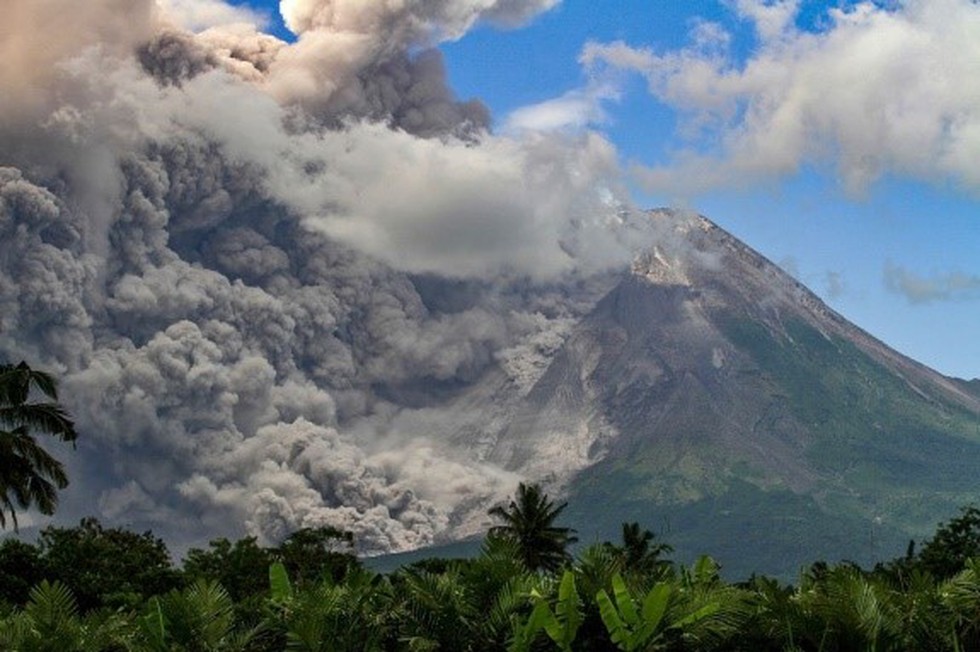
Relevance:
GS I: Indian Geography
Dimensions of the Article:
- Mt Merapi: Indonesia’s Most Active Volcano
- About the Ring of Fire
- Why are there so many volcanoes in the Ring of Fire?
Mt Merapi: Indonesia’s Most Active Volcano
- Mt Merapi is a highly active volcano in Indonesia and is known for its frequent eruptions. Located on the island of Java near Yogyakarta, it has steep slopes and dense vegetation on its lower sides.
- Merapi is Indonesia’s most active volcano, with more than 130 active volcanoes in the country.
- It stands at 2,911 metres tall and is located near the centre of the island of Java.
- Merapi’s last significant eruption was in 2010, which resulted in more than 300 deaths and forced 280,000 residents to evacuate the surrounding areas.
- The name Merapi means “Mountain of Fire” in the Javanese language.
Impact:
- Due to its frequent eruptions, Merapi poses a significant threat to the surrounding areas and populations.
- The 2010 eruption of Merapi was one of the most deadly in recent history, resulting in widespread destruction and displacement of residents.
- The Indonesian government has implemented measures to monitor and prepare for future eruptions, including setting up evacuation routes and warning systems for nearby communities.
About the Ring of Fire
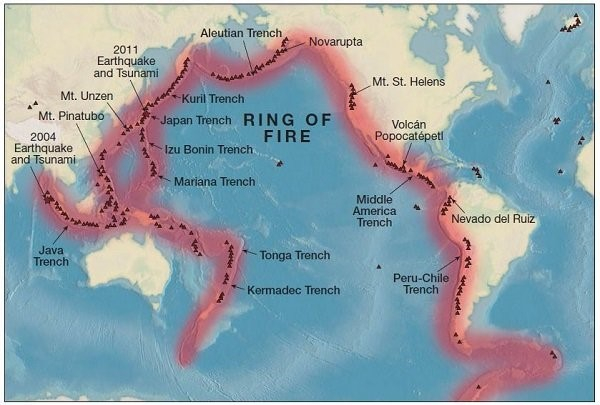
- Many volcanoes in the Ring of Fire were created through a process of subduction. And most of the planet’s subduction zones happen to be located in the Ring of Fire
- It is a string of at least 450 active and dormant volcanoes that form a semi-circle, or horse shoe, around the Philippine Sea plate, the Pacific Plate, Juan de Fuca and Cocos plates, and the Nazca Plate.
- There is a lot of seismic activity in the area.
- 90 per cent of all earthquakes strike within the Ring of Fire
Why are there so many volcanoes in the Ring of Fire?
- The tectonic plates move non-stop over a layer of partly solid and partly molten rock which is called the Earth’s mantle.
- When the plates collide or move apart, for instance, the Earth moves, literally.
- Mountains, like the Andes in South America and the Rockies in North America, as well as volcanoes have formed through the collision of tectonic plates.
- Many volcanoes in the Ring of Fire were created through a process of subduction. And most of the planet’s subduction zones happen to be located in the Ring of Fire
-Source: The Hindu





